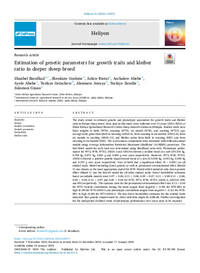Estimation of genetic parameters for growth traits and kleiber ratio in dorper sheep breed

Authors:
The study aimed to estimate genetic and phenotypic parameters for growth traits and Kleiber ratio in Dorper sheep breed. Data used in this study were collected over 12 years (2012–2023) at Debre Birhan Agricultural Research Center sheep research station in Ethiopia. Studied traits were body weights at birth (WT0), weaning (WT3), six month (WT6), and yearling (WT12) age; average daily gains from birth to weaning (ADG0-3), from weaning to six months (ADG3-6), from six months to yearling (ADG6-12); and Kleiber ratios from birth to weaning (KR1) and from weaning to six months (KR2). The (co)variance components were estimated with different animal models using Average Information Restricted Maximum Likelihood (AI-REML) procedure. The best-fitted model for each trait was determined using likelihood ratio tests. Phenotypic performance for WT3, WT6, WT12, ADG0-3 and ADG3-6 showed a decline trend at a rate of 0.216 kg, 0.794 kg, 0.671 kg, 2.601 g and 4.865 g over years respectively. However, WT3, WT6, WT12, ADG0-3 showed a positive genetic improvement trend at a rate of 0.029 kg, 0.043 kg, 0.049 kg and 0.257 g over years respectively. Year of birth had a significant effect (P < 0.001) on all studied traits. Model including direct genetic as well as permanent environmental effect (Model 2) was chosen as the most appropriate model for WT0. Model which included only direct genetic effect (Model 1) was the best-fit model for all other studied traits. Direct heritability estimates based on suitable models were 0.07 ± 0.06, 0.11 ± 0.06, 0.09 ± 0.07, 0.11 ± 0.09 0.11 ± 0.06, 0.00 ± 0.04, 0.15 ± 0.07 and 0.00 ± 0.04 for WT0, WT3, WT6, WT12, ADG0-3, ADG3-6, KR1 and KR2 respectively. The variance ratio for the permanent environmental effect was 0.13 ± 0.04 for WT0. Genetic correlations among the traits ranged from negative (−0.39) for WT0-KR1 to high (0.99) for WT3-ADG0-3 and phenotypic correlations ranged from negative (−0.31) for WT0-KR1 to high (0.98) for WT3-ADG0-3. The low direct heritability estimates for the studied traits indicated that genetic improvement by direct selection might be difficult. Further investigation for the unexpected declined trend of phenotypic performance over years need to be required.
